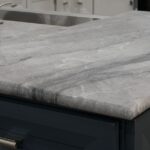Granite is a beautiful and very resistant stone, being one of the best and most famous materials for countertops and other applications. However, being a natural stone, it’s also prone to staining. So, if your slab ends up staining some day, you should know how to get a granite stain remover.
Natural stones are naturally porous. This means that many substances such as liquids and oils can lodge themselves into those pores. If it has strong color, like wine or coffee, after it dries it’ll leave the pigments in the pores, creating the stains. Natural stones are usually sealed to prevent that, but sometimes that’s not enough.
So, removing a stain means getting something into those pores to take out those pigments. While there are many kinds of products that can do that, you have to pick one that doesn’t end up damaging the stone or creating other kinds of stains.
To help you with that, we’ll tell you how you can get a granite stain remover.
Granite’s low porosity makes it a great option for a countertop. Do want to know more about the features of granite countertops? Then be sure check out our definitive guide on them!
Granite Stain Remover: Some Products You Can Use
If you know that what you’re dealing with is a stain and not an etch, then these products may help you remove it. They’re some are everyday cleaning products, so you probably have them at home already.
Detergent
Detergent mixed with water is the most basic granite stain remover. It’s a great organic solvent, meaning it can dissolve organic compounds like the pigments that drinks can leave behind. And it’s also very gentle, meaning it won’t damage the stone.
Dishwasher detergent is especially great for that, as it’s made to clean those kinds of substances.
To use it, get the mixture and apply it over the stain, then scrub it with a bristle brush or something similar. This works great for stains that are more recent and closer to the surface. If it worked, the stain should at least start looking lighter after a while.
Poultice
Poultice is a paste that is great at drawing out stains from pores. It’s very absorbent and easy to make, making it a great choice for dealing with more difficult stains.
Poultice is made from baking soda mixed with some other liquid. The liquid you should use depends on the kind of stain you’re dealing with.
If the stain is oil-based, that is, created by stuff like grease, cooking oil or a cream, you’ll want to use water or acetone. Otherwise, you should use 6% hydroxide peroxide. Mix the liquid and the baking soda until you get a very thick paste.
Then, apply this paste over the stain. You should make the coating ¼ to ½ inch thick, and spread it to leave a 1-inch border the goes beyond the stain. Then, cover it with plastic wrap and tape it to the stone, make some small holes on it, and leave it for 24 hours.
After the time has passed, remove the plastic. It should be dry and hard now. If it isn’t, leave it for some more time. If it is, take out the wrap and leave it for another 24 hours. Then, remove it with a plastic scraper, clean the area with water and dry it with a soft cloth.
If it worked, the stain should be lighter now. While poultice is very good at removing stains, you’ll still need to do this process 4 or 5 times before that stain completely disappears.
Other Granite Stain Removers You Could Try
If you know that the stain comes from something very greasy, you can also try using corn starch. Just put some over the stain, leave it for about 15 minutes, then clean it up with soapy water. Like baking soda, corn starch is very good at drawing out stains. You could also use it as a replacement for baking soda to make poultice if you need to.
If the stain is caused by rust, something common for kitchen and barbecue countertops, your best bet is going for a rust remover, as it specializes in it. Should the stain prove to be too hard to remove, you can also use the rust remover to make poultice and use it that way.
Otherwise, if you’re dealing with mold or mildew, you should use products that specialize in removing them. However, you also need to inform yourself about to them know if they’re acidic or could react with the granite, so you don’t end up etching it by mistake. Bleach in small amounts could also be helpful, but if you use too much it can etch the stone.
Etch or Stain?
Before picking a product to use, though, it’s important to know whether what you’re dealing with is a stain or an etch.
A stain is caused by a liquid drying and leaving its pigments behind. It tends to make the stone darker and in many cases can be removed by using the right products.
An etch, on the other hand, is a kind of damage created by some products, especially some acidic products like vinegar. It’s not made by pigments, but by the product reacting with the stone. It normally makes the stone lighter instead of darker.
If it’s an etch, a granite stain remover won’t be able to remove it, because the reaction done is permanent. In this case, you’ll need to get the stone polished to be able to remove the etch.
Also, if water made the stain, you probably don’t need to worry. It should evaporate after some time and leave the granite intact. If you notice it’s taking too long, that means you should reseal the stone. However, if it’s hard water, then it may end up leaving a stain, because it’ll leave the minerals behind.

When All Else Fails…
If you’ve got an etch or a stain that won’t come off, that means you’ll need some deep cleaning. In theoe cases, the only way to remove them and make the stone look nice again is to polish it and reseal it.
As granite is a very hard stone, you need some heavy equipment to polish it, like a grinder, as well as special protective equipment. Sealing is another process that needs the appropriate equipment and experience with it to give it a nice finish.
So, if you need to get rid of a tough stain, be sure to contact us! We specialize with stone countertops, and we know how help you.
If you need, we can also send a specialist to assess the problem and figure out the best solution. Just get in touch with us using our contact form!



